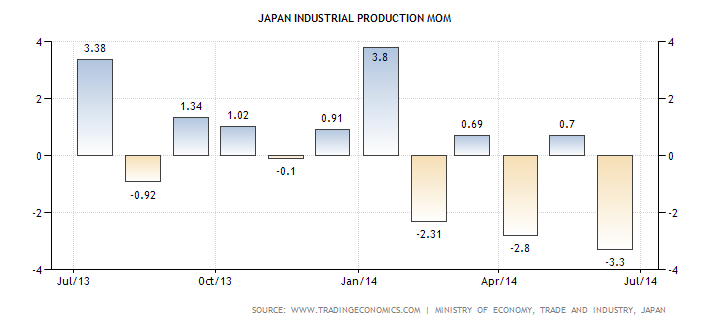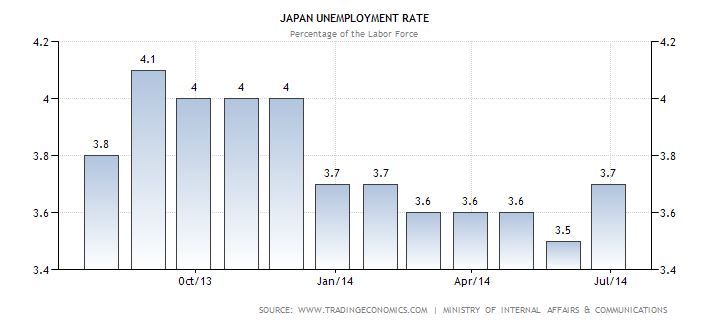Signs are growing that the Japanese economy, our second biggest export market, is weaker than thought, and that the impact of the radical economic policies of Prime Minister Shinzo Abe are fading.
As a result, some analysts believe the country could be in danger of sliding back into a deflationary trap late this year or in early 2015, if the Bank of Japan’s huge spending program isn’t ramped up further.
A series of key economic figures for June have confirmed the slow down – and the belief that economic growth in the three months could be worse than forecast.
It will certainly be negative, mostly because of the April 1 rise in the countries sales tax to 8% from 5%. Some estimates now suggest the economy could have shrunk by well over 3% (on an annual basis) in the three months to June.
Yesterday we learned that industrial production in June – a key economic indicator for Japan, fell by a more than expected 3.3% annual rate, instead of a forecast 1.2% and an 0.7% rise in May (which was weaker than forecast), and an industry estimate for a fall of 0.7%.
The 3.3% fall was the largest since March 2011, in the aftermath of the tsunami and then the Fukushima nuclear scandal. The report showed falls in output in almost all industries, combined with rising inventories, not a good look for the economy.
Japan’s industrial output falls

A drop in passenger-car production led the fall as the country’s car industry grapples with weak demand after the sales tax rise, and expectations of a surge in export demand for cars (a key part of the government’s economic plans) remains unfulfilled.
But there might be hope – this month’s survey forecast a 2.5% gain for July and a 1.1% rise in August. Last month’s survey had estimated a 1.5% gain in July output.
Japan’s retail sales fell 0.6% in June compared to June 2013.
That was an acceleration from May’s 0.4% decline, though it remained well shy of the 4.3% drop seen in April, when the tax rise started.
And another surprise was a rise in Japan’s ultra low jobless rate in June to 3.7% from 3.5%.
Economists had expected no change.
It was the first rise in almost a year, but the important figure of the number of applicants to each vacant job was 1.1, the highest since 1992 and indicating a very tight jobs market.
And Japanese household spending continued to fall in June as consumers showed little sign of returning to spending, as the Abe economic plans suggests they should be doing.
Japan’s unemployment rate above forecasts

Last week the trade account for June revealed a bigger than expected deficit in June as exports fell instead of rising, as had been forecast.
Weaker exports of cars, machinery and electrical parts and equipment were some of the areas to surprise, while imports rose 8.4%, driven by higher raw material costs for commodities such as non ferrous metals, foodstuffs and especially LNG.
Deflation is disappearing and the consumer price index is back still positive, although it is starting to weaken. Japan’s core consumer price index rose 1.3% from a year earlier in June, after adjustment for the April 1 tax change, down on the 1.4% rate in May.
The growth rate of the core index, which tracks a basket of goods and services excluding volatile fresh food, has fallen from 1.5% in April, a high for over five years.
The BOJ and the government wants to see it rising by 2% around spring next year, but the central bank has conceded that core inflation could fall back to 1% later in the year, before rising again in early 2015.
And a big part of the Abe plan is to get consumers spending – after the impact of the tax rise. Part of that is to convince Japanese employers to increase wages, but that is proving hard.
With little nominal wage growth and now rising deflation, the average Japanese worker’s real, price-adjusted earnings in May were 3.8% below what they were a year earlier, according to government data.
If that doesn’t change and with export growth remaining weak, it’s hard to see how the Abe economic plan can continue working without some significant change.
And Mr Abe has to decide by the end of this year if the second stage of the rise in the sales tax rate (to 10%) will happen and when.
His popularity is now under 50% and more questions are being asked about his economic plan (and non-economic issues such as his nationalism).













